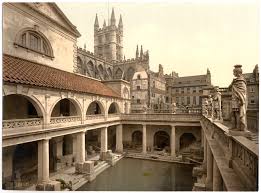Roman Bath houses are one of the most impressive relics of the Roman era. Bathing had great cultural significance in the social life of ancient Rome. Historians estimate that ancient Rome had more than nine hundred bathhouses. They were a standard feature of any town of Rome.

Public Roman Bath houses
Though the rich Roman noblemen had private baths in their mansions, it is the public bathhouses which were the most impressive buildings of a Roman town. The small public Roman bathhouses were called Balneum and could accommodate up to three hundred bathers.
There were much larger versions called thermae which could accommodate more than a thousand persons at a time. These bathhouses consisted of the following chambers.
1.The Atrium was the chamber immediately after entrance. It was the ground where the bathers could take light exercise or simply a refreshing walk.
2.The Caldarium was the chamber of hot baths.
3.The Tepidarium was the chamber of a warm bath.
4.The Frigidarium was the chamber of a cold bath.
5.Some bathhouses offered a Sudatorium which is a moist steam bath.
6.Another optional feature was the Laconicum i.e. a dry steam bath.
7.Apart from these bathing chambers, all bathhouses contained a gym.
8.Gardens, galleries, restaurants, and shops occurred around the Roman bathhouses.

Some important facts
1.The ancient Roman bathhouses were owned by the state. Under the Republic, the bathhouses were modest in size but they grew to huge proportions under the Roman Empire.
2.Citizens had to pay an entry fee to use the bath.
3.There were separate facilities for men and women and often the time was also different. Women were given smaller chambers and lesser time. Children were not allowed.
4.Public slaves gave massages to the bathers.
5.Wealthy citizens were often accompanied by slaves to carry the oil and towels required for bathing. Oil was used as soap was not yet known. The dirt was scraped off the body with the help of sticks called strings.
6.The water in the bathhouses was supplied from the nearby streams or rivers. Sometimes, an aqueduct was constructed for the purpose.
7.For the hot baths, the water was heated on log fires.
8.The bath houses were generally decorated with marbles and statues. The floor was covered by mosaic.
9.Refreshments were a must.
10.The Roman bathhouses were an important part of the social scene. It is here that people met for news, gossip, discussions in addition to getting clean.



